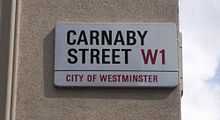Misha Black

Sir Misha Black OBE KBE (16 October 1910 – 11 October 1977) was an Russian-born British architect and designer. In 1933 he founded with associates in London the organisation which became the Artists’ International Association. From 1959 to 1975 he was a professor of industrial design at the Royal College of Art in London, England. During his tenure at the Royal College of Art, he became President of the International Council of Societies of Industrial Design (Icsid) from 1959-1961. He was also a Fellow of the Chartered Society of Designers, and winner of the Minerva Medal, the Society's highest award. He was knighted in 1972.[1] Between 1974 and 1976 Black was President of the Design and Industries Association.[2] He was responsible for designing Westminster's iconic street name signs. He also designed the famous black/brown/orange/yellow moquette originally used by London Transport and also the West Yorkshire Passenger Transport Executive in the late 1970s onwards.
Earlier association with railway design was the external styling of British Railways Southern Region British Rail Class 71 electric locomotives of 1958 and Western Region British Rail Class 52 diesel locomotives of 1961. On 27 July 2003 at Salisbury station, preserved Class 52 D1015 normally named "Western Champion" was unveiled carrying temporary "Sir Misha Black" nameplates.[3]
He played an active part in UNESCO. His brother was the philosopher Max Black.
The Sir Misha Black Awards
The Royal College of Art (RCA), the Faculty of Royal Designers for Industry (RDI), the Royal Academy of Engineering, the Design and Industries Association and the College of Medallists established the Sir Misha Black Awards to commemorate professor Sir Misha Black, whose pioneering work played a crucial role in the development of design in Britain. The Sir Misha Black Awards are unique in honouring the exceptional role of individuals and institutions within design education. Recipients include prestigious design educators such as Max Bill (1982), Ettore Sottsass (1999), and Santiago Calatrava (2002).
Works
- Exhibition Design (1950)
Books
- The Black Papers on Design
Other
- In 1943, with Milner Gray, Sir Misha Black founded Design Research Unit - a London based Architectural, Graphic Design and Interior Design Company.
External links
References
- Encyclopaedia Judaica, 2nd ed.
- ↑ The London Gazette: (Supplement) no. 45678. p. 6255. 3 June 1972. Retrieved 3 January 2012.
- ↑ Misha Black at the archINFORM database
- ↑ D1015 is owned by the Diesel Traction Group
|